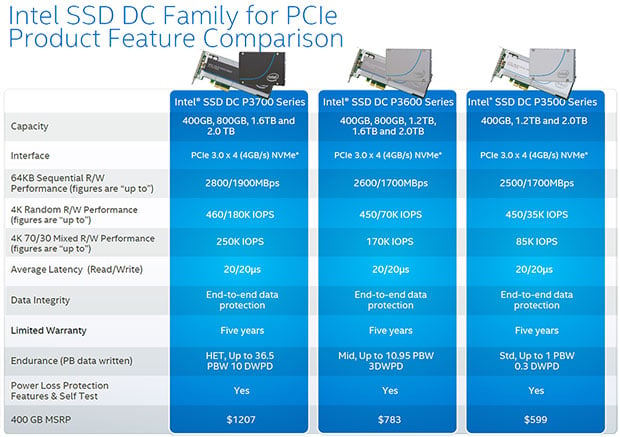Intel SSD DC P3700 NVMe PCIe Review
Introduction and Specifications
The pace of innovation on in the solid state storage market hasn’t slowed a bit in the last few years. Numerous manufacturers continue to release newer, faster SSDs at regular, frequent intervals. There’s been an underlining limitation, however, that’s prevented monumental leaps in performance—the aging SATA interface. Current SATA implementations simply don’t offer the bandwidth necessary to keep pace with the continuous innovation happening in solid state storage. As such, more and more manufactures have been looking to higher bandwidth interfaces like PCI Express.
We have already looked at a number of PCI Express based drives, with wide ranging price points and performance levels. Some of the drives use proprietary technologies, while others are simply SATA RAID configurations, bridged to PCI Express. Intel, however, recently released a whole new family of PCI Express solid state drives, the SSD DC P3x00, featuring an NVMe controller. NVM Express is a low-latency, scalable host controller interface designed specifically for PCI Express-based solid state drives. NVMe (Non-Volatile Memory Express) offers a number enhancements over legacy interfaces, like support for parallel operations and support for up to 64K commands within a single I/O queue to the drive. NVMe also offers many enterprise-targeted features like end-to-end parity data protection, enhanced error reporting, and virtualization, among other things. All in all, NVMe can provide up to 6x the throughput of a SATA 6Gbps interface.
We’ve been testing one of the higher-end Intel DC P3700 series drives for a few days now and have all of the details for you here. Check out the drive and its specifications below, and then strap in as we profile its performance on the pages ahead...
|
As you can see in the chart above, Intel has three series of NVMe-based solid state drives in the pipeline, the DC P3700 we’ll be showing you here, the DC P3600, and the DC P3500. All of the drives will be offered in capacities ranging from 400GB on up to 2TB (though the 1.2TB and 1.6TB models aredo you n’t featured in all series), with varying performance levels and endurance. The top of the line DC P3700 series is rated for up to 460K/180K 4K random read/write IOPs, with sequential reads/writes topping out at up to 2.8GB/s and 1.9GB/s. Endurance is rated for up 36.5 PBW (petabytes written). Performance drops slightly for the DC P3600 and DC P3500, but endurance ratings are much lower versus the DC P3700. All of the drives carry a 5 year warranty and offer end-to-end data protection, though.
Pre-Production Intel SSD DCP3700 800GB Drive, Front View
The particular drive we’ll be showing you here is an 800GB Intel SSD DC P3700. The drive features the aforementioned Intel NVMe controller, paired to Intel 20nm MLC NAND flash memory. The drive is outfitted with a PCIe x4 electrical interface (max bandwidth up to 4GB/s) and it has a half-height form factor.
The new Intel controller used on these drives in an 18-channel design, which can offer significantly more bandwidth (at lower latencies) than the 4 – 10 channel controllers used on most consumer-class SATA SSDs. This particular 800GB drive is outfitted with 36 NAND packages (18 front, 18 rear), along with some DRAM cache. There are also an array capacitors on the PCB, which provide some measure of power-loss protection. The Intel SSD DC P3700 is also outfitted with a large heatsink that covers the controller and all of the front-mounted NAND, but we found it hardly got warm to the touch, even after hours of testing. Unlike some previous PCIe-based SSDs we’ve looked at, which required a robust cooling solution, the Intel SSD DC P3700 should be fine as long as there is moderate air-flow through the system.
Pre-Production Intel SSD DCP3700 800GB Drive, Rear View
Though it uses a new interface, the Intel SSD DC P3700 is bootable and the latest versions of Windows (8.1 and Server 2012 R2) already have native support. However, to achieve peak performance, you’ll need to install drivers for the device (Intel’s drivers significantly outperformed the native Windows drivers). We should also mention that the SSD DC P3700 has full support for TRIM and idle garbage collection, as you’d expect from a modern SSD.
All told, the Intel SSD DC P3700 improves upon virtually every aspect of a solid state drive. The NVMe interface has much lower overhead and is closer to the CPU, which will improve latency and CPU utilization. It offers much higher bandwidth and IO, and high endurance as well.








